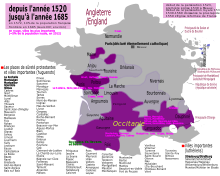Reformed Church of France
This article needs additional citations for verification. (December 2011) |
| Reformed Church of France | |
|---|---|
Calvinist | |
| Polity | Presbyterian |
| Associations | World Alliance of Reformed Churches, World Council of Churches, Protestant Federation of France |
| Origin | 1559; merged in 2013 with the Evangelical Lutheran Church in France to form the United Protestant Church of France |
| Separated from | Catholic Church |
| Members | 300,000 at the time of merger |
| Official website | https://www.eglise-protestante-unie.fr/ |
The Reformed Church of France (
The church was a member of the Protestant Federation of France (Fédération protestante de France), the World Communion of Reformed Churches and the World Council of Churches.
The church had approximately 300,000 members at the time of merger, distributed in a somewhat unequal fashion throughout French metropolitan territory, with the exception of
History
Background to formation

Emerging from the
The revocation of the Edict of Nantes began a period of systematic state persecution known in
In the 19th century, the Awakening (le Réveil) and other religious movements influenced the French and European Reformed churches; this was also accompanied by division within French Protestantism. In 1871 the Reformed congregations in German-annexed Alsace and the newly formed
The Reformed Church of France today
The horrors of the
In June 2012, it was announced that the Reformed Church of France and the Evangelical Lutheran Church of France would unite to form the United Protestant Church of France (Eglise Protestante unie de France or EPUF).[2][3]
Beliefs
The 30th General Synod held 1872-1873 was the first national synod held in 213 years. The General Synod arrived at a new confession of faith, the main principles of which were rejected by a significant minority. The official practice of the Calvinist faith in France distanced itself from stricter interpretations. The current Reformed Church adopted liberal currents in Calvinist theology including pietism, neo-Lutheranism, Methodism, social Christianity, etc. The opportunities, substance and limits of theological pluralism are set out in the 1936 Declaration of Faith (which is read at the opening of all synods, adherence to which is required of all pastors licensed to preach and the laity who express membership of the Calvinist church)
Organisations and relations
The church was organised according to a
Sister denominations and fraternal relations
The Reformed Church in France was involved in the work of other Protestant churches in France, through its membership of the Protestant Federation of France (Fédération protestante de France)
In 2005, Pope Benedict sent a message to the national synod of the Reformed Church of France, which thanked the Pontiff for this "gesture of consideration".
Missions
In common with other churches, the Reformed Church in France operated a missionary service (le Défap). The mission service supported reformed churches in Africa and Oceania, primarily those arising from the work of the now defunct Paris Evangelical Missionary Society (Société des missions évangéliques de Paris)
Theological seminaries
Training for the ministry took place in the Institut Protestant de Théologie, which formed part of the Protestant theology faculties of the Universities of Paris and Montpellier.
Universities, colleges, and schools
The church also operated a distance education programme for lay members called Théovie.
Symbols
Until recently, the Huguenot cross was not an official symbol of the Reformed Church of France. Rather it has served as a sign of popular recognition. The official logo of the former reformed churches was the "burning bush". A new logo of the Reformed Church of France was adopted, a stylised representation of the burning bush with the Huguenot cross as an insert and the Latin phrase Flagror Non Consumor (I am burned, I am not consumed) taken from Exodus 3:2,[4] "...and he looked, and, behold, the bush burned with fire, and the bush was not consumed."
See also
- Camisard
- John Calvin
- Huguenots in South Africa
- French Australian
References
- ^ "Glasgow Churches Together".
- ^ "Offer to sell domain: Protestantnews.eu".
- ^ "Archived copy". Archived from the original on 12 March 2016. Retrieved 14 June 2012.
{{cite web}}: CS1 maint: archived copy as title (link) - ^ Exodus 3:2 King James Version (Oxford Standard, 1769)
External links
- Official website (in French)
